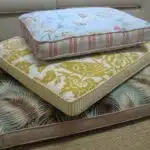As a laundry and linen care expert, I understand the importance of keeping your bedding clean and fresh. Bedding is one of the most important items in your home, as it directly affects your health and well-being. However, many people are unsure how often they should be washing their bedding to maintain optimal hygiene levels.
The frequency with which you wash your bedding depends on various factors, including personal hygiene, lifestyle habits, and environmental conditions. Neglecting to wash your bedding regularly can lead to an accumulation of dirt, dust mites, and other allergens that may cause health problems. Therefore, it is crucial that you develop a regular schedule for washing your bedding to ensure that it remains clean and hygienic. In this article, we will discuss how often you should be washing your bedding based on different factors to help you maintain a healthy sleeping environment.
Personal Hygiene Habits
Maintaining personal hygiene habits is essential for overall health and well-being. One aspect of personal hygiene that often goes overlooked is the importance of clean bedding. Keeping your sheets and linens fresh and clean is not only important for good sleep but also plays a significant role in maintaining a healthy lifestyle.
The importance of keeping your bedding clean cannot be overstated. Bedding can accumulate dirt, sweat, oil, dead skin cells, and other bodily fluids over time. This buildup can lead to unpleasant odors, skin irritations, respiratory problems, and even allergies. Dirty bedding can also provide a breeding ground for bacteria and bed bugs, which can cause serious health issues.
However, there are challenges with maintaining clean bedding. Many people have busy schedules or may not have access to laundry facilities. Additionally, environmental factors such as humidity and dust can make it difficult to keep bedding fresh for extended periods. Despite these challenges, it is critical to prioritize cleanliness when it comes to your bed linens to ensure optimal health benefits.
Environmental Factors
Just like how personal hygiene habits are important, environmental factors also play a significant role in the maintenance of bedding. Just as we clean our bodies daily to avoid bacteria and germs, we must also focus on the cleanliness of our bedding. Washing your sheets once a week is the standard recommendation. However, it’s crucial to note that different types of bedding require different care.
Sustainability practices should be applied in every aspect of our lives, including laundry and linen care. Eco-friendly options such as using plant-based laundry detergents and avoiding fabric softeners can significantly reduce your carbon footprint. Additionally, opting for natural fibers like organic cotton or bamboo for your bedding can make a big difference in sustainability practices.
When it comes to type of bedding, it’s essential to know how to care for each one properly. For example, silk sheets require gentle washing and should not be exposed to direct sunlight or heat sources. Linen is another fabric that requires specific care; it should be washed with lukewarm water and hung dry instead of being placed in the dryer. Knowing how to take care of your bedding correctly will extend their lifespan and keep them looking fresh for longer periods.
Transitioning into the subsequent section about ‘type of bedding,’ understanding how different materials react during laundering is crucial in maintaining their quality over time.
Type Of Bedding
Bedding material options play an important role in determining the frequency of washing. Materials such as cotton and linen are breathable and absorbent, making them ideal for everyday use. On the other hand, materials such as silk and satin require more delicate handling and should be washed less frequently to avoid damage. Additionally, synthetic materials like polyester and microfiber tend to accumulate more dust and dirt, which may require more frequent washing compared to natural materials.
To maintain bedding properly, it is essential to follow some simple maintenance tips. First, always check the care label instructions before washing any bedding item. Use a mild detergent and avoid using bleach or fabric softeners that can damage the fibers over time. It is also recommended to wash bedding items separately from other laundry to prevent tangling or snagging. Lastly, ensure that bedding items are completely dry before storing them away.
In conclusion, proper maintenance of bedding depends on its material type and laundering requirements. Following these simple tips can help prolong the lifespan of your bedding items while ensuring they remain clean and fresh for longer periods. In the subsequent section, we will delve into how often sheets should be washed based on their use and material type.
Frequency For Sheets
- It is recommended to wash sheets and bedding on a weekly basis to maintain hygiene and reduce allergens.
- Factors that may impact the frequency of washing include the number of people sleeping in the bed, the type of material the sheets are made of, and the amount of perspiration produced during sleep.
- Regular washing of bedding can reduce dust mites and allergens, create a more comfortable sleep environment, and prolong the life of the bedding.
- Frequently washing sheets can also help to maintain the softness of the fabric and the vibrancy of the colors.
- Washing bedding on a regular basis also helps to remove body oils, sweat, and other residues from the sheets.
- It is important to follow care instructions for sheets and bedding to ensure that the fabric is not damaged in the washing process.
Recommended Washing Frequency
A clean bed is a welcoming sight for anyone who wants to relax and unwind after a long day. However, the importance of cleanliness goes beyond just aesthetics. Clean bedding is crucial for maintaining good health. As a laundry and linen care expert, I recommend washing your sheets at least once a week.
Regular washing of your bedding helps eliminate dust mites, bacteria, and other allergens that can cause respiratory problems. It also gets rid of dead skin cells and oils that accumulate on your sheets over time. Failure to wash your sheets regularly can lead to the proliferation of these harmful microorganisms, which can cause infections and other health problems.
The benefits of washing your bedding frequently cannot be overstated. Not only does it keep you healthy, but it also ensures that you enjoy a good night’s sleep without having to worry about allergic reactions or other health issues. So if you’re looking to improve the quality of your life, make it a habit to wash your sheets often and enjoy the many benefits that come with it!
Factors Impacting Frequency
Factors determining frequency of sheet washing can vary based on several aspects. One major factor is hygiene considerations. Individuals who sweat a lot or have oily skin may need to wash their sheets more frequently than those who do not. Similarly, people with allergies or respiratory problems may require more frequent washing to prevent the buildup of dust mites and other allergens that can exacerbate their symptoms.
Another factor impacting frequency is the season and climate. During hot and humid weather, individuals may sweat more and produce more oils, which can lead to faster accumulation of bacteria and dead skin cells on their bedding. In contrast, during colder months when indoor heating systems are in use, moisture levels in the air tend to be lower, reducing the likelihood of bacterial growth on sheets.
Lastly, lifestyle factors such as smoking habits or pet ownership can also impact how frequently bedding needs to be washed. Smokers may require more frequent washing due to the buildup of smoke residue on their sheets, while pet owners may need to wash their bedding more often if their pets sleep in bed with them.
In conclusion, while it is generally recommended to wash your sheets at least once a week for optimal hygiene and health benefits, several factors can influence how frequently you should wash your bedding. Understanding these factors can help you make informed decisions about your linen care routine and ensure that your bedding remains clean and comfortable year-round.
Benefits Of Washing Frequently
As a laundry and linen care expert, it is important to stress the benefits of washing bedding frequently. Not only does it contribute to better hygiene, but it also promotes better sleep quality and overall health. Regular washing removes dead skin cells, sweat, and bacteria that accumulate on sheets over time. These substances can cause skin irritation, bad odors, and even trigger allergies or respiratory problems in some individuals.
To achieve the best washing practices for bedding, it is recommended to use hot water and a quality detergent that effectively removes dirt and stains. It is also important to avoid overloading the washing machine as this can lead to ineffective cleaning and damage to the fabric. Additionally, using fabric softeners or dryer sheets may seem like a good idea for added freshness and softness, but they can actually leave residue on the sheets which can irritate sensitive skin.
Incorporating regular sheet washing into your linen care routine not only ensures optimal hygiene but also extends the lifespan of your bedding. Not only will your sheets look cleaner and smell fresher, but you will also experience better sleep quality knowing that you are sleeping on clean and comfortable bedding. Remembering these best practices for washing bedding can help ensure that you are providing the best possible care for yourself or those you serve with your linen care expertise.
Frequency For Pillowcases
Pillowcases are an essential component of bedding that protects our faces from direct contact with the pillow’s surface. It is imperative to wash them regularly to maintain hygiene and avoid potential skin irritations. Neglecting to clean your pillowcases can lead to a buildup of oils, dead skin cells, dirt, and bacteria that can cause acne breakouts and other facial skin problems. Therefore, it is necessary to establish good nighttime habits by changing and washing your pillowcases at least twice a week.
To ensure that you’re not exposing yourself to harmful bacteria or other allergens from unwashed bedding, here are some tips for maintaining the cleanliness of your pillowcases:
- Use a gentle laundry detergent without harsh chemicals or perfumes.
- Wash your pillowcases in hot water at 60°C (140°F) to kill any germs or bacteria.
- Avoid using fabric softeners as they can damage the fibers of your pillowcase.
- Dry your pillowcases on low heat or hang them outside in direct sunlight for natural disinfection.
- Consider investing in multiple sets of pillows so that you can alternate between clean ones while washing the used ones.
Skin irritations caused by dirty pillows are no joke. If you’re prone to acne breakouts or have sensitive skin, it’s essential to wash your pillowcases even more frequently. Establishing a consistent habit of cleaning them regularly will go a long way towards ensuring healthy skin and a good night’s sleep.
Moving forward, let’s discuss how often we should be washing our comforters to maintain overall bed hygiene without risking exposure to dust mites or other allergens.
Frequency For Comforters
As we have discussed the frequency for washing pillowcases, it is now time to move on to the topic of caring for duvets. A duvet or comforter, much like a pillowcase, is an essential element in achieving a comfortable and restful sleep. However, unlike pillowcases that are washed more frequently, duvets do not need to be cleaned as often.
Choosing the right comforter is key in maintaining its longevity and cleanliness. When purchasing a duvet, it is important to consider both the material and fill type. Down-filled duvets require extra care as they should be dry cleaned or professionally laundered. On the other hand, synthetic-filled duvets can be washed at home using a mild detergent on a gentle cycle.
The frequency for washing comforters may vary depending on usage and personal preference. Typically, comforters should be washed every six months to a year. However, if you suffer from allergies or have pets that often sleep on your bed, it may be necessary to wash more frequently. By following these guidelines and choosing the right comforter for your needs, you can ensure that your bedding remains clean and comfortable for years to come.
Moving forward into our next section about frequency for duvet covers, it is important to note that proper care of your bedding extends beyond just the duvet itself. Duvet covers provide an added layer of protection against dirt and stains while also adding style to your bedroom decor. Stay tuned for our expert tips on how often to wash your duvet covers.
Frequency For Duvet Covers
Some people may question the necessity of using duvet covers, arguing that they are an added expense and unnecessary hassle. However, duvet covers offer numerous benefits, including protection for the duvet itself and easier maintenance. When it comes to frequency for washing these covers, it largely depends on the material they are made from.
Duvet covers come in a variety of materials, including cotton, linen, silk, and polyester. Cotton and linen are popular choices due to their breathability and durability. Silk offers a luxurious feel but requires more delicate care. Polyester is a more affordable option but may not be as comfortable or long-lasting as natural fibers. Regardless of the material chosen, it is recommended to wash duvet covers every two weeks to maintain freshness.
Regularly washing duvet covers not only keeps them clean but also extends the life of the duvet itself. Duvets can be difficult to clean and may require professional laundering if soiled or stained. Using a cover provides an extra layer of protection against spills, sweat, and oils from skin and hair. Additionally, since duvets cannot be easily washed like sheets can be, using a cover allows for easier maintenance and upkeep.
Moving on to mattress pads/protectors…
Frequency For Mattress Pads/Protectors
Mattress care is an essential aspect of maintaining a clean and healthy sleeping environment. Mattress pads/protectors play an important role in protecting your mattress from spills, stains, and dust mites. As such, it is necessary to keep them clean and fresh to extend the life of your bedding.
To prevent stains from setting in, it is recommended that you wash your mattress pad/protector every two weeks. This frequency ensures that dirt and sweat do not accumulate on the surface, which can cause odors and discolorations. However, if you are prone to allergies or have pets that sleep on the bed with you, it may be necessary to wash them more frequently.
When washing your mattress pad/protector, follow the manufacturer’s instructions carefully. Use warm water and a mild detergent to avoid damaging the waterproofing layer. Avoid using bleach or fabric softeners as they can break down the fibers over time. Dry on low heat or air dry for best results.
In summary, regular cleaning of your mattress pads/protectors is crucial for stain prevention and maintenance of good hygiene practices. Following proper care instructions will help extend their lifespan while ensuring you get a good night’s sleep. Up next in our discussion about bedding frequency is the importance of washing blankets regularly to maintain optimal freshness and comfort for a cozy slumber experience.
Frequency For Blankets
Have you ever wrapped yourself up in a warm, cozy blanket only to realize it’s been months since you last washed it? It’s easy to forget about washing your blankets when they’re not used as frequently as sheets or towels, but neglecting them can lead to an accumulation of dirt, dust mites, and even allergens. So how often should you be washing your blankets?
The frequency with which you wash your blankets depends on a variety of factors, including the type of material they’re made from and how often they’re used. Generally speaking, it’s recommended that all blankets be washed at least once every three months. However, if you have allergies or suffer from asthma, you may want to consider washing them more frequently.
When it comes to storing your blankets, it’s important to keep them in a cool, dry place where they won’t be exposed to moisture or direct sunlight. Avoid folding them tightly or hanging them up for extended periods of time as this can cause creases and damage over time. Instead, try rolling them loosely and storing them in a breathable cotton bag or container. By following these simple tips for blanket storage and maintenance, you can help prolong their lifespan and ensure that they stay clean and fresh for years to come.
Transition: Now that we’ve covered the frequency for blankets, let’s move on to another important item in your bedding collection – throw pillows.
Frequency For Throw Pillows
Clean bedding is essential for a healthy and comfortable sleep environment. In the previous section, we discussed the frequency for washing blankets. Now, let’s focus on another important aspect of bedding – sheets and pillowcases. Depending on your personal preferences and habits, you should aim to wash your sheets and pillowcases once every one to two weeks.
Cleaning methods vary based on the material of your bedding. For example, cotton or linen sheets can be machine washed with warm water and mild detergent. However, silk or satin sheets require more gentle care and should be hand washed or dry cleaned. Pillowcases are often overlooked but can accumulate oils from our skin and hair, leading to breakouts or irritations. To keep them clean, flip them inside out before washing to ensure all areas are properly cleaned.
When it comes to decorative options for your bedding, throw pillows and shams can add a touch of style to any bedroom decor. However, they too need regular cleaning to maintain their appearance and hygiene. Here are some tips for cleaning decorative pillows and shams:
- Check the care label: Some materials may require special cleaning methods such as dry cleaning.
- Spot clean when possible: If there are small stains or spills on decorative pillows or shams, spot clean them immediately to prevent permanent damage.
- Use a fabric brush: To remove dust or debris from decorative pillows or shams without damaging the material, use a soft-bristled fabric brush.
- Wash in cold water: When it’s time to wash your decorative pillows or shams, use cold water and a gentle cycle to avoid shrinking or damaging the material.
In summary, keeping your bedding clean is crucial for both comfort and health reasons. Sheets and pillowcases should be washed at least once every one to two weeks using appropriate cleaning methods for each material type. Decorative options such as throw pillows and shams also require regular cleaning using proper techniques such as spot cleaning and using a fabric brush. In the next section, we will discuss the frequency for washing decorative shams, another important aspect of bedding hygiene.
Frequency For Decorative Shams
When it comes to bedding, decorative shams are often overlooked but they play an important role in the overall look and feel of a bed. Decorative shams are usually used for aesthetic purposes rather than functionality, meaning they do not come into direct contact with your skin as often as other bedding items. However, this does not mean that decorative shams should be neglected when it comes to cleaning.
It is recommended to wash decorative shams every three to four weeks if used regularly. If the shams are not used frequently or have minimal contact with the skin, washing them once a month is sufficient. It is important to note that decorative shams made of delicate materials such as silk or velvet may require more gentle care and less frequent washing.
Cleaning decorative pillows can be done either by hand or machine depending on the material and care instructions. A gentle hand wash using mild detergent or dry cleaning may be necessary for delicate fabrics such as silk or velvet. For machine-washable materials, use a gentle cycle with cold water and mild detergent. Avoid using bleach or fabric softeners as they can damage the material and cause discoloration over time.
To maintain the freshness of your decorative shams between washes, there are several tips you can follow. Placing them in a well-ventilated area away from direct sunlight can help prevent odors from developing. You can also use a fabric freshener spray or lightly sprinkle baking soda onto the sham before vacuuming it off after 30 minutes. By following these simple steps, you can ensure that your decorative shams stay clean and fresh even between washes.
Tips For Maintaining Freshness Between Washes
Vacuuming can help remove dust and other allergens, and can also extend the time between washes. Deodorizing products can help reduce the scent of freshness between washes and should be used sparingly. Airflow is important to reduce bacteria that can cause odors, and mattress and pillow covers can help provide additional protection. Sunlight can help eliminate odors naturally, and detergents, stain removal, fabric care, odor eliminators, cleaning products, sanitizing, spot treating, and allergen control are all important parts of maintaining freshness between washes.
Vacuuming
To maintain the freshness of your bedding between washes, one effective strategy is to vacuum regularly. Vacuuming helps to remove dust and allergens that can accumulate on your sheets and mattress, especially if you suffer from allergies or asthma. It is recommended to vacuum your bedding once a week, particularly if you have pets that shed hair or dander.
When vacuuming your bedding, it’s important to use a high-quality vacuum cleaner with a HEPA filter. This type of filter captures small particles like pollen, dust mites, and pet hair that can trigger allergies or asthma symptoms. Be sure to pay attention to areas where dust tends to accumulate, such as the corners of your mattress or under the bed. Additionally, consider using a handheld vacuum cleaner for hard-to-reach areas like pillows or comforters.
Regularly vacuuming your bedding not only helps to keep it fresh but also promotes better sleep hygiene. When you eliminate allergens and dust from your sleeping environment, you reduce the risk of respiratory issues and promote overall health. By incorporating this simple practice into your cleaning routine, you’ll be able to enjoy clean and fresh bedding every night without having to wash them as frequently.
Remember that maintaining cleanliness is an integral part of ensuring the longevity of your bedding while keeping it free from allergens and other harmful substances. With proper care practices like regular vacuuming in place, you can rest easy knowing that you are creating a healthy environment for yourself and anyone else who shares your bed.
Deodorizing
In addition to regular vacuuming, there are other effective strategies you can use to maintain the freshness of your bedding between washes. One such strategy is deodorizing, which helps to eliminate unwanted odors that can accumulate on your sheets and mattress. There are several DIY deodorizers that you can use, including natural remedies that are safe and effective.
One popular natural remedy for deodorizing bedding is baking soda. Simply sprinkle a generous amount of baking soda onto your mattress and let it sit for several hours or overnight. The baking soda will absorb any unpleasant odors and can be easily vacuumed up in the morning. Another option is to mix equal parts water and vinegar in a spray bottle and lightly mist your bedding. Vinegar has natural deodorizing properties that can help to eliminate odor-causing bacteria.
When using DIY deodorizers, it’s important to test them on a small area first to ensure they don’t cause any damage or discoloration. Additionally, be sure to follow the manufacturer’s instructions for any commercial products you may use. By incorporating these simple deodorizing strategies into your cleaning routine, you’ll be able to enjoy fresh-smelling bedding in between washes while promoting better sleep hygiene.
Common Bedding Stains And How To Remove Them
As a laundry and linen care expert, I have seen a variety of stains on bedding over the years. Two common types are coffee and sweat stains. Removing these stains can be challenging, but with the right techniques, it is possible.
To remove coffee stains from bedding, start by blotting up as much of the liquid as possible with a clean towel. Then, mix equal parts white vinegar and cold water and apply the solution to the stain. Let it sit for 15-20 minutes before rinsing with cold water. If the stain persists, create a paste using baking soda and water and apply it to the affected area before washing as usual.
When tackling sweat stains on bedding, first pre-treat the area with a mixture of hydrogen peroxide and dish soap. Let it sit for 30 minutes before washing in hot water with an enzyme-based detergent. If the stain remains after washing, repeat the process before drying.
- Did you know that using club soda can help remove coffee stains from bedding?
- Sweat stains on bedding can be especially stubborn – try pre-treating them with vinegar before washing.
- When removing any type of stain from bedding, always avoid using hot water as this can set the stain into the fabric permanently.
In summary, removing common bedding stains like coffee or sweat can seem daunting at first but with some simple steps, you can effectively get rid of them. By following these techniques or trying out some other popular methods like using lemon juice or saltwater solutions, you’ll be able to keep your linens looking fresh all year round! Now let’s move onto recommended detergents and fabric softeners to help maintain your sheets even longer.
Recommended Detergents And Fabric Softeners
After discussing common bedding stains and how to remove them, it is important to address the question of how often to wash bedding. There is no one-size-fits-all answer to this question as it largely depends on individual preferences and habits. However, a general guideline is to wash bedding at least once every two weeks.
It is worth noting that some people may prefer to wash their bedding more frequently due to personal hygiene or health concerns. For example, individuals with allergies or sensitive skin may benefit from washing their bedding weekly or even more frequently. Additionally, natural alternatives such as vinegar or baking soda can be used in place of traditional detergents for those who are concerned about the impact on skin.
When selecting detergents and fabric softeners for washing bedding, it is important to consider both their effectiveness and their environmental impact. Choosing eco-friendly options not only helps reduce waste but also benefits the environment as a whole. There are many brands on the market that offer eco-friendly options without sacrificing quality or effectiveness. By making conscious choices when it comes to laundry care, we can all play a small role in protecting our planet.
Table:
| Frequency | Benefits | Drawbacks |
|---|---|---|
| Weekly | Reduces allergens and bacteria buildup; Maintains fresh scent | May cause wear and tear on fabrics; Time-consuming |
| Bi-weekly (every two weeks) | Balances cleanliness with convenience; Reduces water usage | May not be sufficient for those with allergies or sensitivities |
| Monthly | Saves time and resources; Can prolong lifespan of fabrics | May lead to accumulation of dirt, sweat, and other contaminants |
In conclusion, while there is no set rule for how often one should wash their bedding, washing at least once every two weeks generally strikes a good balance between cleanliness and practicality. Natural alternatives can be used for those who have concerns about harsh chemicals impacting their skin. Moreover, choosing eco-friendly options can help reduce waste and benefit the environment. By making informed choices about laundry care, we can ensure that our bedding is both clean and sustainable.
Conclusion And Recap Of Key Points
Consistent washing of bedding is a crucial aspect of ensuring good hygiene and health. The buildup of sweat, body oils, dead skin cells, and other bodily fluids in our bedding can lead to the growth of bacteria, dust mites, and other harmful microorganisms. These can cause allergies, asthma attacks, skin irritations, and other health problems if not adequately addressed.
Infrequent washing of bedding can have significant consequences on our health. It allows for the accumulation of allergens that trigger respiratory problems such as asthma or hay fever. In addition to triggering allergies and respiratory issues, unwashed bedding can also attract bed bugs and other pests which can be detrimental to one’s overall well-being. Therefore it is important for individuals to take their time to wash their bedding regularly.
To ensure optimal hygiene standards in your home it is important always to keep in mind some key points when cleaning your linen. Here are five tips that will help you maintain the highest level of cleanliness:
- Always wash your sheets once a week.
- Use hot water (130°F or higher) when washing your bedding.
- Dry your linen at high temperatures or hang them outside in direct sunlight.
- Replace pillows every two years.
- Encase mattresses and pillowcases with allergy-proof covers.
Consistent washing of bedding should be a top priority for anyone who values their health and wellbeing. Infrequent washing can lead to serious health problems that could have been avoided by taking simple precautions such as regular laundering with hot water and replacing pillows frequently. By following these guidelines individuals can maintain a clean environment that promotes better sleep quality and overall good health without breaking the bank or sacrificing comfort.
Conclusion
The frequency of washing bedding depends on several factors such as personal hygiene habits, environmental factors, and the type of bedding used. While some people may prefer to wash their sheets and pillowcases every week, others may do it every two weeks or even monthly. It is recommended to wash sheets at least once a week to prevent the buildup of sweat, oils, and dead skin cells that can lead to bacterial growth and unpleasant odors.
Pillowcases should be washed more frequently than sheets since they come into direct contact with the face and hair. It is recommended to wash pillowcases every two to three days, especially for those prone to acne or oily skin. To maintain freshness between washes, it is advisable to air out the bedding daily by fluffing pillows and opening windows to allow fresh air circulation.
When it comes to removing common bedding stains such as blood, sweat, or urine, pre-treating with a stain remover before washing can help eliminate deep-set stains. Using a detergent specifically designed for delicate fabrics can also ensure that your bedding stays soft and comfortable after washing.
As a laundry and linen care expert, I recommend following these guidelines for optimal cleanliness and freshness in your bedding. Remember that maintaining good hygiene habits is crucial for overall health and well-being. So ask yourself this rhetorical question – how often do you want your body coming into contact with bacteria-infested sheets? The answer should motivate you towards regular washing of your bedding!
Image Credits
- “Time to wash the bed linen” by goblinbox_(queen_of_ad_hoc_bento) (featured)














![How To Keep Sheets On A Bed: 10 Strategies 14 Bed sheets [Explored 2013-04-27]](https://green-life.blog/wp-content/uploads/2023/04/pH7FwL8jspjq-150x150.jpg.webp)














